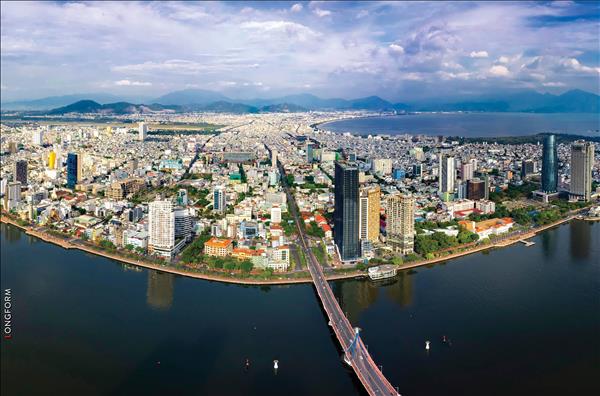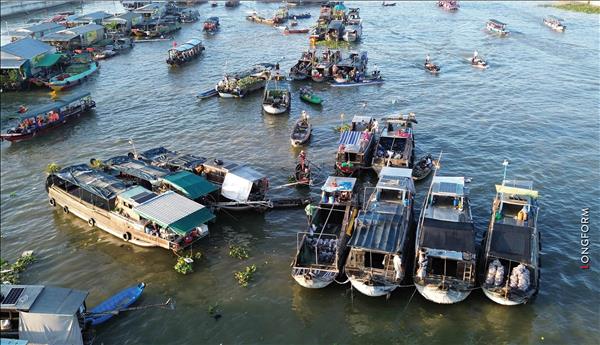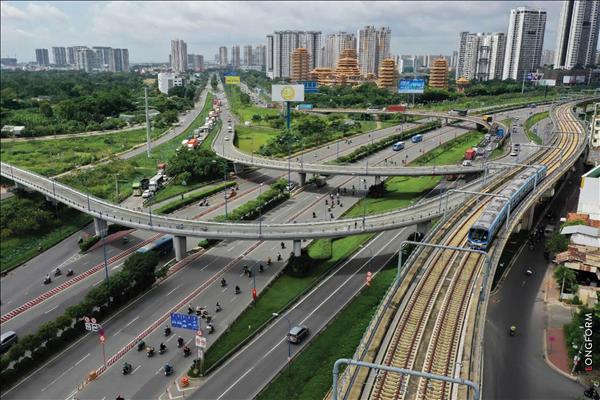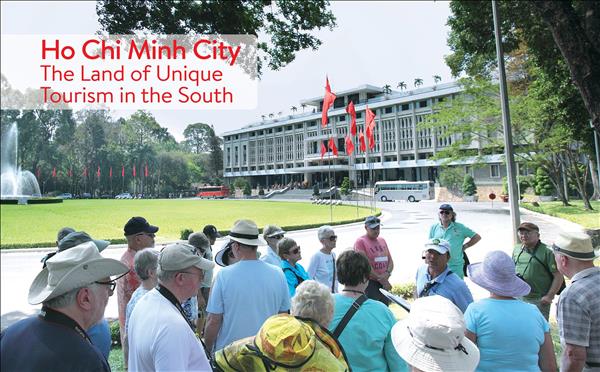Potential and Prospect
The pepper tree, scientifically known as Piper nigrum under the Piperaceae Family originated from India. This variety of tree was planted in Vietnam in the 17th century by the French and was grown in Phu Quoc, Hon Chong and Ha Tien (Kien Giang) by the end of the 19th century. Until the early 20th century, this tree spread to the land of basalt soil in the Southeastern and the Central regions. However, it was not popular and there were only about 400ha for growing pepper trees which yielded about 500tonnes in the 70s.
At present, pepper tree grows mainly in six provinces of Vietnam, including Binh Phuoc with 12,148ha, Dak Nong with 11,154ha, Dak Lak with 12,082ha, Ba Ria-Vung Tau with 9,074ha, Dong Nai with 9,010ha and Gia Lai with 11,245ha. Among them, the provinces in the Central Highlands and the Southeastern region rank first in terms of area and productivity. There are also other pepper growing areas in Phu Quoc and Kien Giang, which have created their trademark in the market, and in Quang Tri.
Vietnam’s pepper export has drastically increased, reaching an annual growth rate of 15-20%. It became the world’s largest pepper exporter with a total export volume of 50,506tonnes, worth 90 million dollars in 2001. In 2014, despite a decrease of the world’s pepper growth rate because of the poor crop in some countries, Vietnam still maintains its stability with a total pepper growing area of 73,500ha, a total pepper productivity of nearly 140,000tonnes and a total export volume of 156,396tonnes (including the imports for re- exporting) that earned 1,204.98 billion dollars.
Vietnam’s pepper has so far been exported to 97 countries and territories in Asia, Europe, America and Africa. Vietnam’s high-quality pepper products for exporting to the US and European countries has increased in recent years. European countries which account for 40% of the market share accept Vietnam’s pepper producing technology and spice products made from Vietnamese pepper.
In 2005, Vietnam joined the International Pepper Community (IPC) and since the country’s accession to the World Trade Organisation, Vietnam’s pepper sector has penetrated more deeply into the international market and successfully conquered the severely selective markets, such as Japan, the Netherlands, the US, Germany and France.
To learn more about Vietnam’s pepper sector, we visited Chu Se District - the capital of pepper in the Central Highlands’ Gia Lai Province where there is the largest pepper output in the whole country and the locals successfully built its brand name of Chu Se pepper.
We visited a pepper farm owned by Dong Quoc Bao, a native from the coastal city of Hai Phong, in Luh Village, Kong H Tok Commune, Chu Se District. Bao has been involved in growing peppers for about 10 years and his farm has now more than 7,000 bushes, including 2,000 bushes for harvest. After expenditures, he earns a profit of some hundreds of million dong/year. He now works as a member of the Chu Se Pepper Association’s Executive Board and has helped many other farmers in the area growing peppers. He also cultivates hundreds of high-quality pepper saplings to supply customers, providing jobs for many local labourers. He now plans to invest in a white pepper processing chain on a farmer household scale.
In the Southeastern region, there are two others who are experts in cultivating peppers and were awarded the title of “The Best Pepper Growers from Vietnam”. They are Tran Huu Thang in Xuan Tho Commune, Xuan Loc District, Dong Nai Province and Nguyen Ba Thinh in Loc An Commune, Loc Ninh District, Binh Phuoc Province.
10 years ago, Tran Huu Thang learned by himself about peppers and then started cultivating this variety of tree. He divided his garden into three plots and experimented with three ways of growing and tending this tree. He then selected the method which helped bring the highest productivity to apply to growing peppers in the whole area. This method helps his peppers have a high yield and high quality and brought his family more money. Recognising the great benefits brought from the tree, he rented more land to expand the area for pepper cultivation and invested in production. He was also a pioneer in applying the advance technology of watering economically and fertilising with pipes which was transferred by the Xuan Loc Centre. After one year of using these systems together with new techniques on tending, his pepper garden reached a total output of 7-10 tonnes/ha each year, twice as high as that in the previous years. His family often makes a profit of billions of dong from bumper crops.
In Binh Phuoc, Nguyen Ba Thinh was famous for growing peppers for many years. His 3.5ha pepper garden always brings high yield and is less affected by insects. He invented the system of watering, fertilising and spraying pesticide which brought him the first prize at Binh Phuoc Province’s Technical Creations Contest and third prize at the national contest.
Thanks to the above great potential and advantages, Vietnam’s pepper has become important in the world’s pepper sector.
Maintaining the position of the world’s number one pepper exporter
At present, about 95% of Vietnam’s total pepper output is exported and Vietnam has now about 200 enterprises involved in processing and trading pepper, including 15 top enterprises which account for 70% of the whole country’s pepper exports. There are five foreign-invested enterprises, occupying 30% of the export market share. Vietnam reached a common ground in terms of pepper processing technology, meeting the customers’ demand. Despite an increase in pepper products made by factories using the advanced technology of international standards, such as ASTA, ESA and JSSA, and the diversity in products, such as black and white peppercorns, ground pepper and small pepper packages, Vietnam mainly exports crude pepper for 7,738 dollars/tonne, lower than the prices of some other countries. If Vietnam’s pepper sector improves the process of producing pepper, the added value of pepper for export will increase and Vietnam’s pepper prices will be equal to or higher than that of other countries in the world. Therefore, the Vietnam Pepper Association suggested the improvement of the quality of pepper products from growing to processing products. The enterprises should invest more in processing and diversifying products in the market to deeply penetrate into the global pepper supply chain.
In reality, many pepper processing enterprises have seen big development, typically Phuc Sinh Corporation which has been bestowed the title of “King of Pepper Exporters” for five consecutive years with 6% of the world’s pepper market share, accounting for 15-17% of Vietnam’s export market share. In recent years, the company has exported over 20,000tonnes/year.
Phuc Sinh Corporation was established in 2001 with a modest amount of capital. However, it quickly took the lead in methods of creating the differences in its products. It selected big peppercorns to sell to customers, processed white pepper and clean and sterilised pepper products. To attract more customers, besides improving PR skills for its staff and devising programmes on product promotion, the company has spent much time conducting research on the culture, tastes and demands of customers and creating trust and prestige in the market. The company also invested in advanced processing technology and building a lab, applied the management system of international standards and selected and strictly controlled the material resources. In 2010, Phuc Sinh became Vietnam’s first enterprise that was selected as the excellent pepper exporter of the world by the World’s Pepper Export Association.
Besides Phuc Sinh, Intimex Group Joint-Stock Company is also evaluated as a powerful enterprise in Vietnam’s pepper sector. With a total pepper output for export of nearly 10,000tonnes/year, Intimex ranks third among pepper exporters. It built a plant to process clean pepper in Binh Duong Province. It was awarded the prize of “The Excellent Pepper Processing Plant” by the International Pepper Association.
To promote the development of Vietnam’s pepper sector, the Vietnam Pepper Association was established in 2001 which serves as a bridge for linking producers, organisations and businesses to create a general strength for the development of production, trade and export. The association implements major national programmes on trade promotion, updates information about pepper products domestically and internationally, encourages the production of clean pepper, connects enterprises with farmers to invest and develop the production and creates a stable, high-quality and clean material resource for the processing industry.
According to the direction for sustainable development of Vietnam’s pepper sector, Vietnam should promote the effective connectivity between scientists, businessmen and farmers. The State should give priority to general scientific and technical research to closely manage the input and research on seedlings, tending and protecting trees, building the process of production in the direction of VietGap in major cultivation areas. The pepper farmers should invest in sustainable intensive cultivation, proper use of fertilizers and pesticide to avoid risks of pandemics and maintain the longevity of trees and increase the output and quality of products. The business should invest in advanced technology and increase the product value. All sectors should make joint effort to help Vietnamese pepper maintain its position in the traditional markets and penetrate into new markets.
The pepper tree, scientifically known as Piper nigrum under the Piperaceae Family originated from India. This variety of tree was planted in Vietnam in the 17th century by the French and was grown in Phu Quoc, Hon Chong and Ha Tien (Kien Giang) by the end of the 19th century. Until the early 20th century, this tree spread to the land of basalt soil in the Southeastern and the Central regions. However, it was not popular and there were only about 400ha for growing pepper trees which yielded about 500tonnes in the 70s.
At present, pepper tree grows mainly in six provinces of Vietnam, including Binh Phuoc with 12,148ha, Dak Nong with 11,154ha, Dak Lak with 12,082ha, Ba Ria-Vung Tau with 9,074ha, Dong Nai with 9,010ha and Gia Lai with 11,245ha. Among them, the provinces in the Central Highlands and the Southeastern region rank first in terms of area and productivity. There are also other pepper growing areas in Phu Quoc and Kien Giang, which have created their trademark in the market, and in Quang Tri.
Vietnam’s pepper export has drastically increased, reaching an annual growth rate of 15-20%. It became the world’s largest pepper exporter with a total export volume of 50,506tonnes, worth 90 million dollars in 2001. In 2014, despite a decrease of the world’s pepper growth rate because of the poor crop in some countries, Vietnam still maintains its stability with a total pepper growing area of 73,500ha, a total pepper productivity of nearly 140,000tonnes and a total export volume of 156,396tonnes (including the imports for re- exporting) that earned 1,204.98 billion dollars.
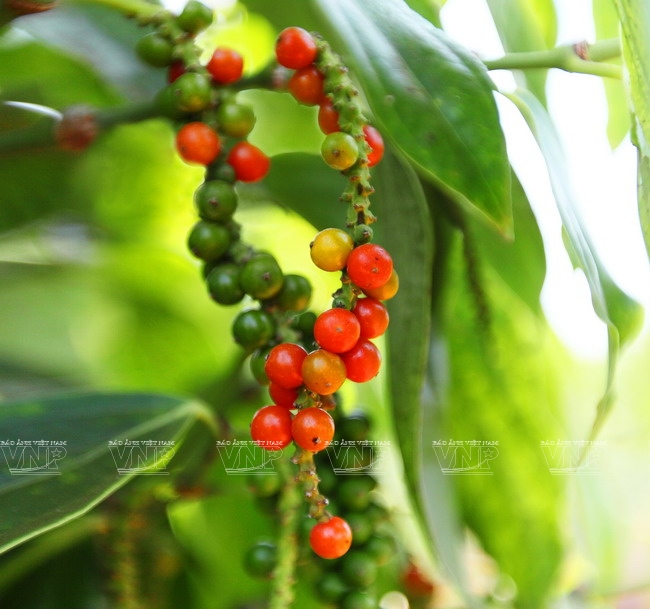 Ripe peppercorns in Gia Lai. Photo: Nguyen Luan/VNP 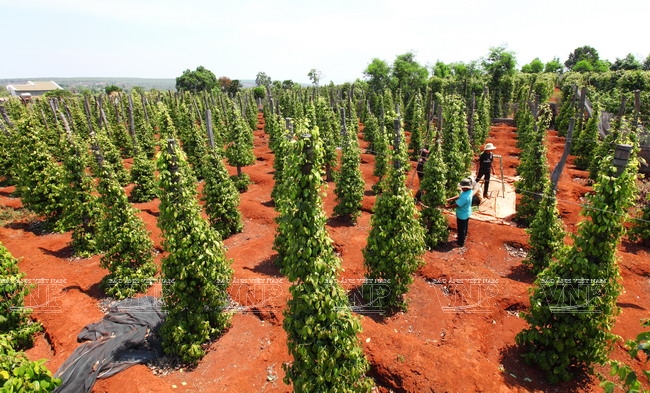 The basalt soil in Gia Lai is very suitable for pepper cultivation. Photo: Nguyen Luan/VNP 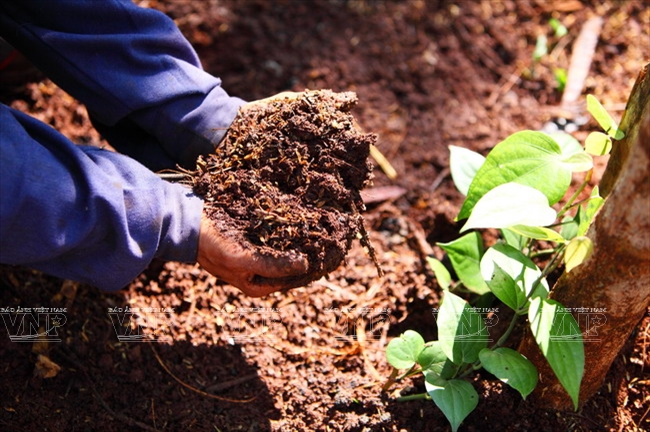 Examining soil quality for pepper cultivation. Photo: Nguyen Luan/VNP 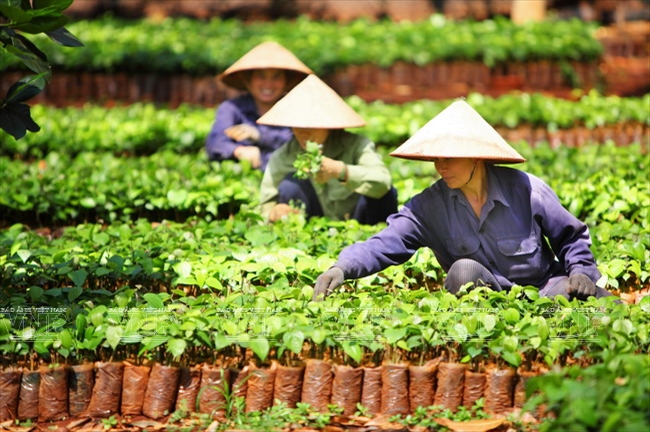 Tending pepper saplings in nurseries in Gia Lai. Photo: Nguyen Luan/VNP 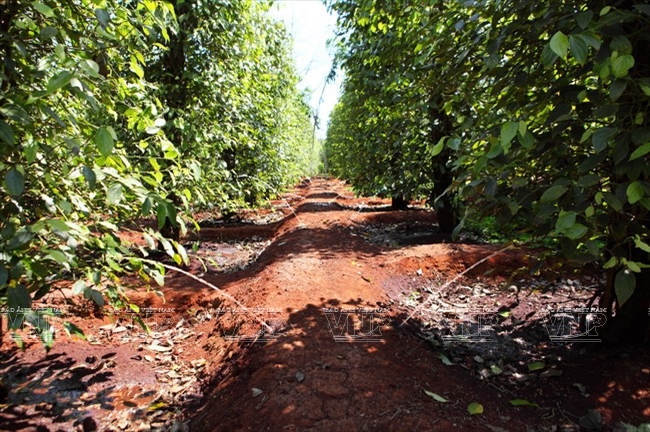 The automatic watering system. Photo: Nguyen Luan/VNP 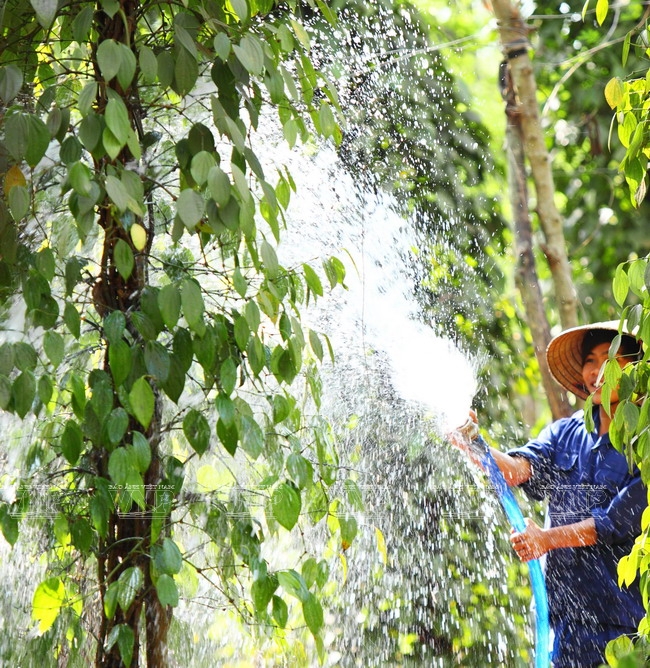 Watering pepper trees. Photo: Nguyen Luan/VNP 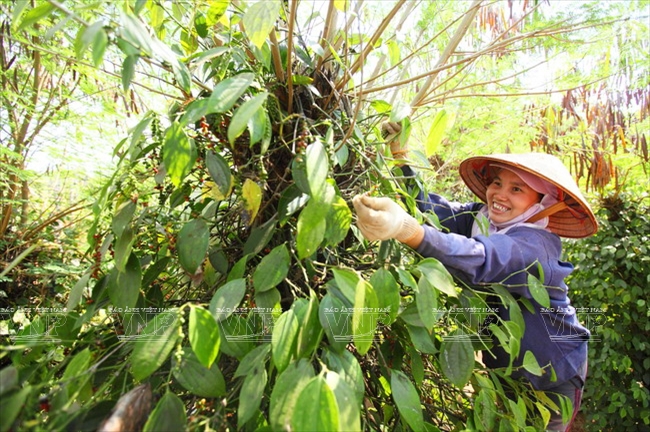 Cleaning up the pepper bushes. Photo: Nguyen Luan/VNP “The Best Pepper Grower from Vietnam” Nguyen Ba Thinh (standing) shares his technical experience with pepper growers. Photo: Nguyen Luan/VNP 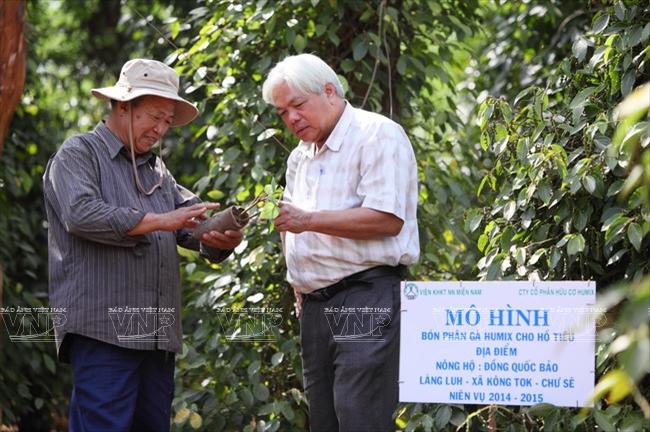 A cadre from Chu Se District’s Pepper Association shares experience in pepper cultivation at the pepper garden of farmer Dong Quoc Bao, Chu Se District, Gia Lai Province. Photo: Nguyen Luan/VNP 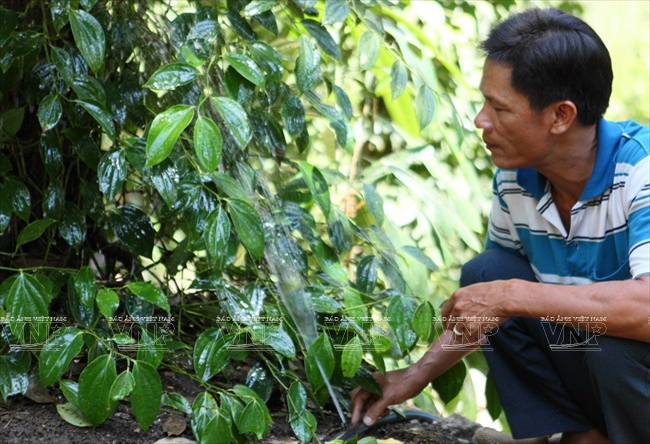 The automatic watering system used in pepper fields is invented by “The Best Pepper Grower from Vietnam” Tran Huu Thang (Xuan Loc District, Dong Nai Province). Photo: Nguyen Luan/VNP 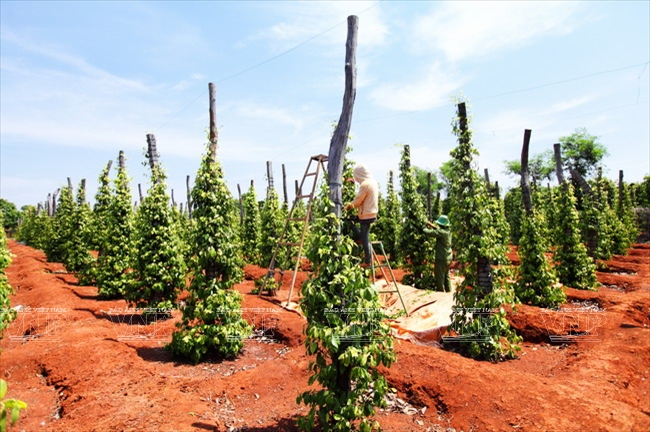 Harvesting pepper. Photo: Nguyen Luan/VNP 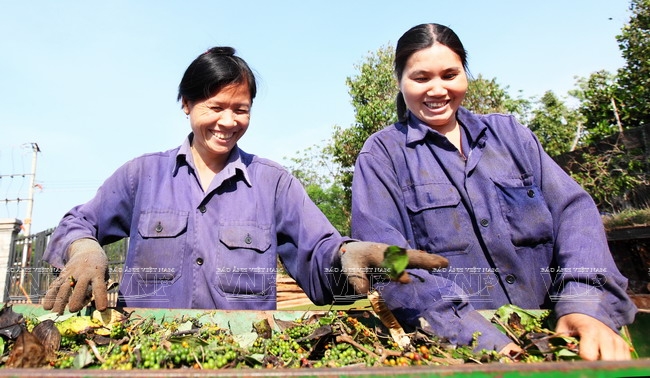 Selecting peppercorn after harvesting. Photo: Nguyen Luan/VNP 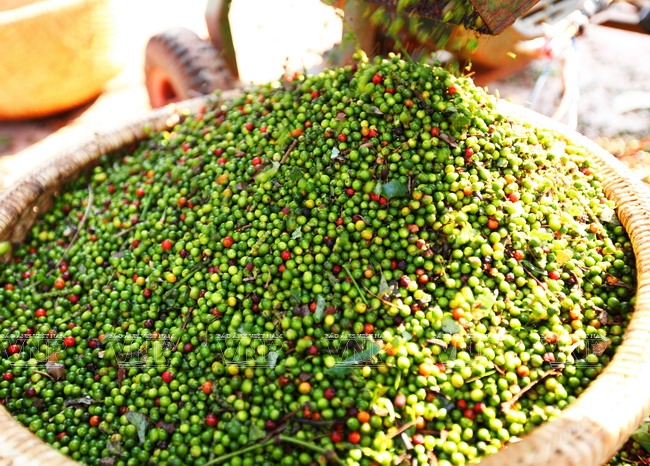 Rubbing to separate pepper from bunches of pepper after harvest. Photo: Nguyen Luan/VNP 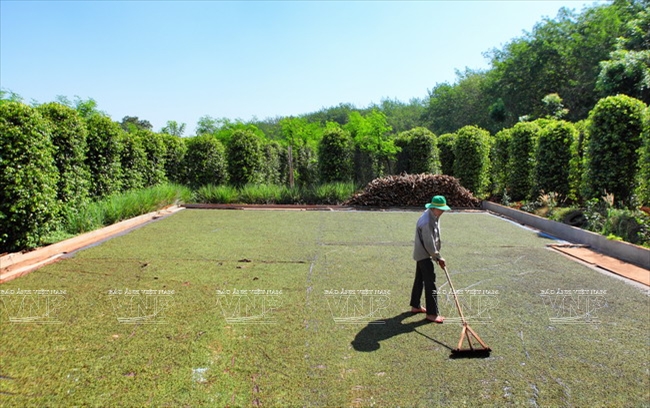 Drying pepper in Loc Ninh, Binh Phuoc. Photo: Nguyen Luan/VNP 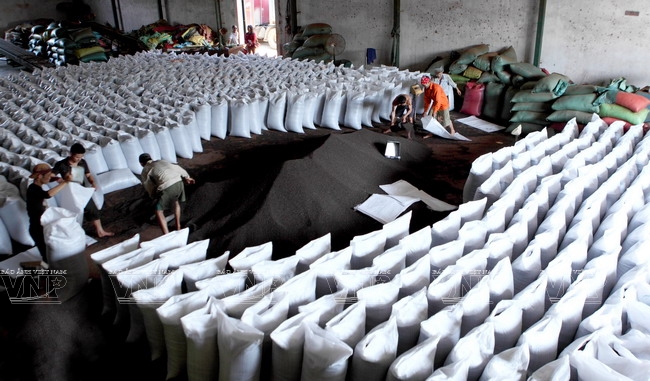 The storage facility of pepper products of Huong Mai Company Ltd., in Chu Se, Gia Lai. Photo: Nguyen Luan/VNP |
Vietnam’s pepper has so far been exported to 97 countries and territories in Asia, Europe, America and Africa. Vietnam’s high-quality pepper products for exporting to the US and European countries has increased in recent years. European countries which account for 40% of the market share accept Vietnam’s pepper producing technology and spice products made from Vietnamese pepper.
In 2005, Vietnam joined the International Pepper Community (IPC) and since the country’s accession to the World Trade Organisation, Vietnam’s pepper sector has penetrated more deeply into the international market and successfully conquered the severely selective markets, such as Japan, the Netherlands, the US, Germany and France.
To learn more about Vietnam’s pepper sector, we visited Chu Se District - the capital of pepper in the Central Highlands’ Gia Lai Province where there is the largest pepper output in the whole country and the locals successfully built its brand name of Chu Se pepper.
We visited a pepper farm owned by Dong Quoc Bao, a native from the coastal city of Hai Phong, in Luh Village, Kong H Tok Commune, Chu Se District. Bao has been involved in growing peppers for about 10 years and his farm has now more than 7,000 bushes, including 2,000 bushes for harvest. After expenditures, he earns a profit of some hundreds of million dong/year. He now works as a member of the Chu Se Pepper Association’s Executive Board and has helped many other farmers in the area growing peppers. He also cultivates hundreds of high-quality pepper saplings to supply customers, providing jobs for many local labourers. He now plans to invest in a white pepper processing chain on a farmer household scale.
In the Southeastern region, there are two others who are experts in cultivating peppers and were awarded the title of “The Best Pepper Growers from Vietnam”. They are Tran Huu Thang in Xuan Tho Commune, Xuan Loc District, Dong Nai Province and Nguyen Ba Thinh in Loc An Commune, Loc Ninh District, Binh Phuoc Province.
10 years ago, Tran Huu Thang learned by himself about peppers and then started cultivating this variety of tree. He divided his garden into three plots and experimented with three ways of growing and tending this tree. He then selected the method which helped bring the highest productivity to apply to growing peppers in the whole area. This method helps his peppers have a high yield and high quality and brought his family more money. Recognising the great benefits brought from the tree, he rented more land to expand the area for pepper cultivation and invested in production. He was also a pioneer in applying the advance technology of watering economically and fertilising with pipes which was transferred by the Xuan Loc Centre. After one year of using these systems together with new techniques on tending, his pepper garden reached a total output of 7-10 tonnes/ha each year, twice as high as that in the previous years. His family often makes a profit of billions of dong from bumper crops.
In Binh Phuoc, Nguyen Ba Thinh was famous for growing peppers for many years. His 3.5ha pepper garden always brings high yield and is less affected by insects. He invented the system of watering, fertilising and spraying pesticide which brought him the first prize at Binh Phuoc Province’s Technical Creations Contest and third prize at the national contest.
Thanks to the above great potential and advantages, Vietnam’s pepper has become important in the world’s pepper sector.
Maintaining the position of the world’s number one pepper exporter
|
"For 14 consecutive years, Vietnam has ranked first in the world in pepper productivity and export, making an important contribution to the national growth rate and increasing the income for farmers. Vietnam’s pepper has been exported to 97 countries and territories in Asia, Europe, America and Africa”. (Do Ha Nam, Chairman of the Vietnam Pepper Association) |
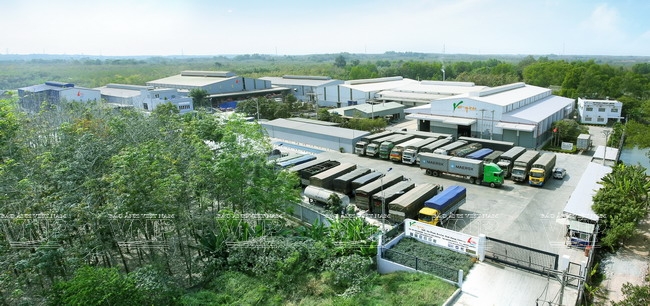 Phuc Sinh Corporation’s large-scale clean coffee processing factory in Binh Duong Province. Photo: Nguyen Luan/VNP 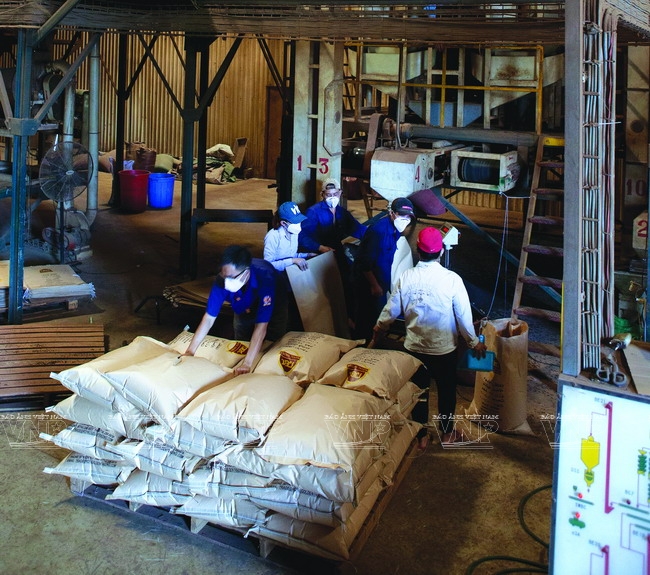 Inside the clean pepper processing factory of Intimex Group Joint-Stock Company. Photo: Le Minh/VNP 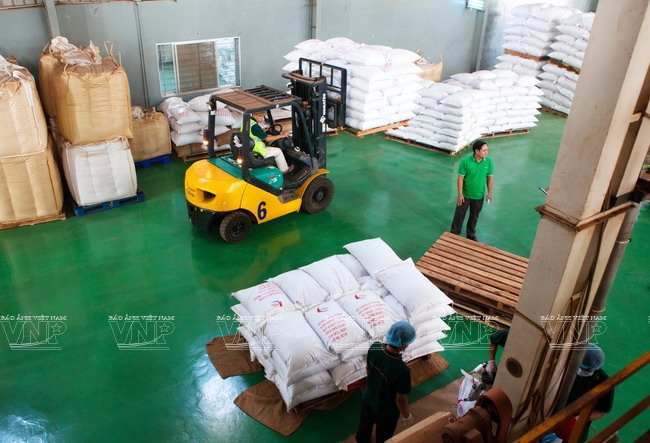 Part of Phuc Sinh Corporation’s clean pepper processing factory. Photo: Le Minh/VNP 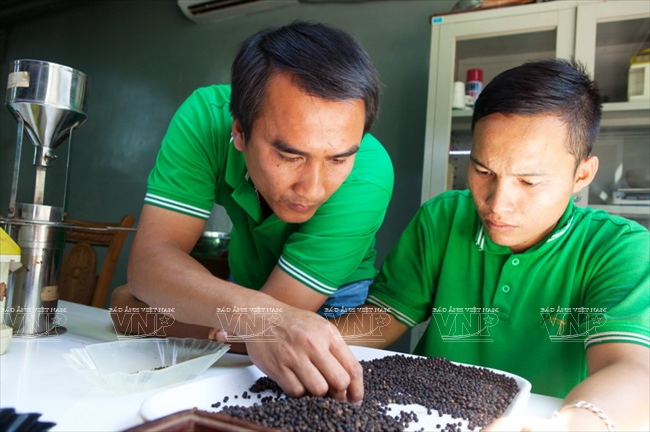 Checking the quality of pepper materials in Phuc Sinh Corporation. Photo: Le Minh/VNP 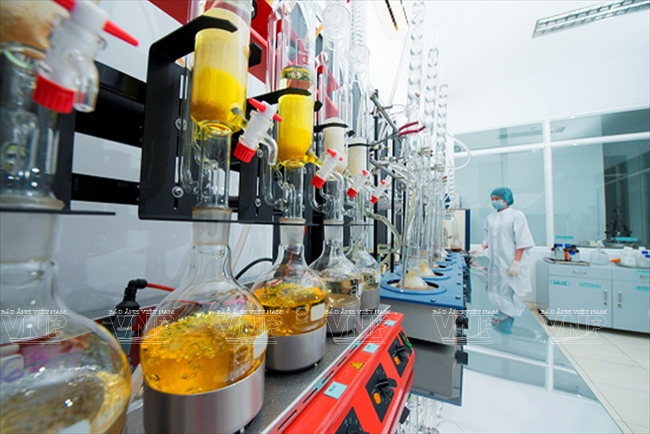 The lab in the clean pepper processing factory of Phuc Sinh Corporation. Photo: File 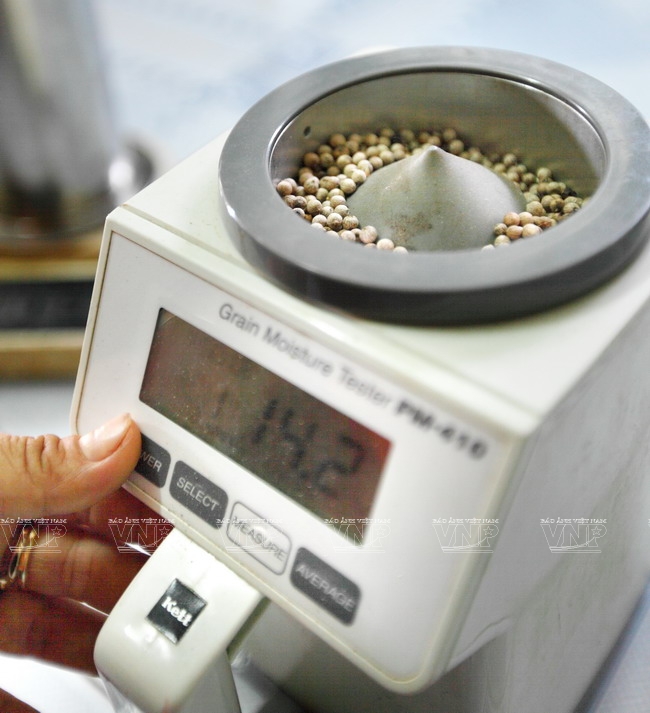 Measuring the humidity of finished pepper. Photo: Nguyen Luan/VNP |
In reality, many pepper processing enterprises have seen big development, typically Phuc Sinh Corporation which has been bestowed the title of “King of Pepper Exporters” for five consecutive years with 6% of the world’s pepper market share, accounting for 15-17% of Vietnam’s export market share. In recent years, the company has exported over 20,000tonnes/year.
Phuc Sinh Corporation was established in 2001 with a modest amount of capital. However, it quickly took the lead in methods of creating the differences in its products. It selected big peppercorns to sell to customers, processed white pepper and clean and sterilised pepper products. To attract more customers, besides improving PR skills for its staff and devising programmes on product promotion, the company has spent much time conducting research on the culture, tastes and demands of customers and creating trust and prestige in the market. The company also invested in advanced processing technology and building a lab, applied the management system of international standards and selected and strictly controlled the material resources. In 2010, Phuc Sinh became Vietnam’s first enterprise that was selected as the excellent pepper exporter of the world by the World’s Pepper Export Association.
Besides Phuc Sinh, Intimex Group Joint-Stock Company is also evaluated as a powerful enterprise in Vietnam’s pepper sector. With a total pepper output for export of nearly 10,000tonnes/year, Intimex ranks third among pepper exporters. It built a plant to process clean pepper in Binh Duong Province. It was awarded the prize of “The Excellent Pepper Processing Plant” by the International Pepper Association.
To promote the development of Vietnam’s pepper sector, the Vietnam Pepper Association was established in 2001 which serves as a bridge for linking producers, organisations and businesses to create a general strength for the development of production, trade and export. The association implements major national programmes on trade promotion, updates information about pepper products domestically and internationally, encourages the production of clean pepper, connects enterprises with farmers to invest and develop the production and creates a stable, high-quality and clean material resource for the processing industry.
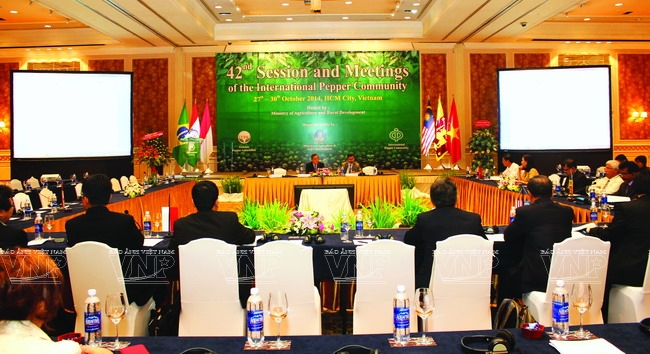 An international conference on pepper. Photo: File 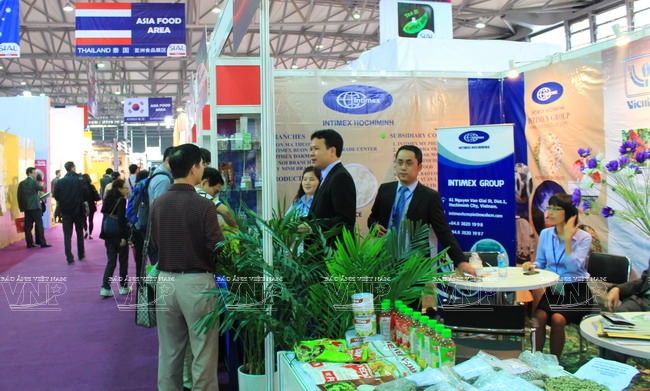 The stall displaying pepper products of Intimex at Sial Shanghai 2014. Photo: File 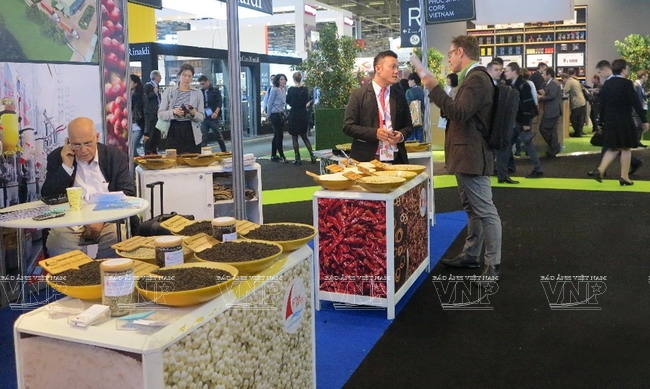 The stall displaying pepper products made by Phuc Sinh Corporation at an international trade fair in the US. Photo: File 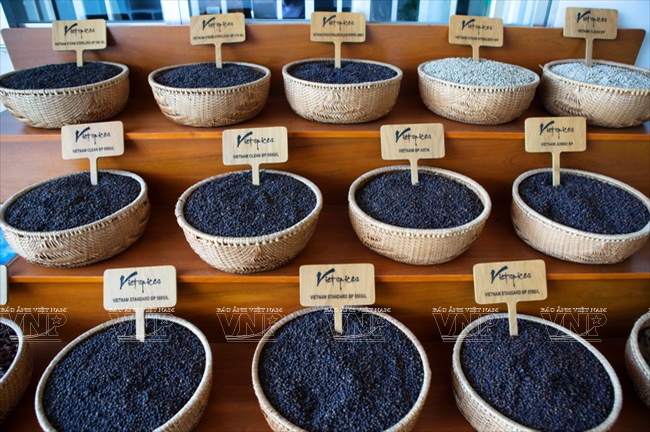 Cleaning pepper products made by Phuc Sinh Corporation. Photo: Le Minh/VNP 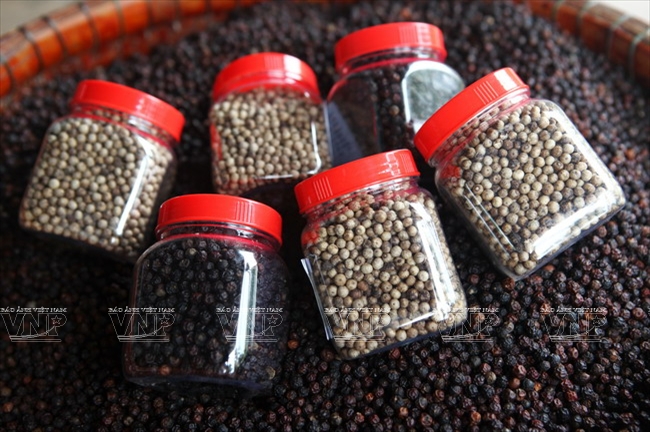 Phu Quoc pepper is famous for its high quality in both domestic and foreign market. Photo: Le Minh/VNP |
According to the direction for sustainable development of Vietnam’s pepper sector, Vietnam should promote the effective connectivity between scientists, businessmen and farmers. The State should give priority to general scientific and technical research to closely manage the input and research on seedlings, tending and protecting trees, building the process of production in the direction of VietGap in major cultivation areas. The pepper farmers should invest in sustainable intensive cultivation, proper use of fertilizers and pesticide to avoid risks of pandemics and maintain the longevity of trees and increase the output and quality of products. The business should invest in advanced technology and increase the product value. All sectors should make joint effort to help Vietnamese pepper maintain its position in the traditional markets and penetrate into new markets.
Story: Van Quy
Photos: Nguyen Luan, Le Minh and Files
Photos: Nguyen Luan, Le Minh and Files
phamtrangnhung


